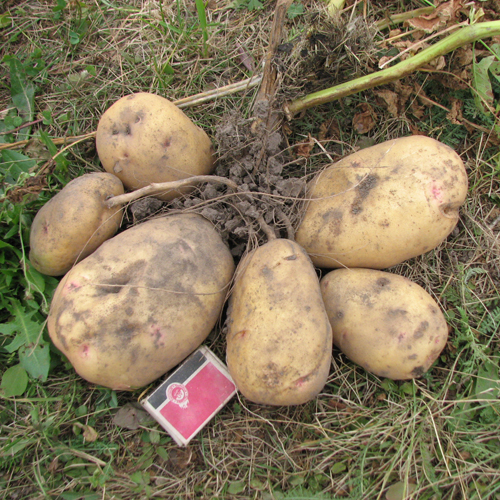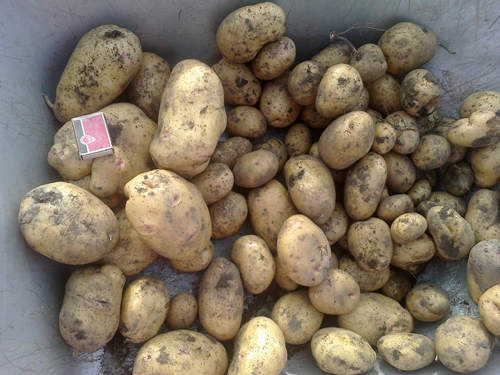Potato variety Giant
The giant is a medium-ripening table potato (Solanum tuberosum). Bred in Russia by specialists of the A. G. Lorkh All-Union Potato Research Institute. To obtain, we used a variety Effect and a numbered hybrid 946-3. Our hero was included in the state register of breeding achievements of the Russian Federation in 2013. Approved for cultivation in three regions of the country: Central, Volgo-Vyatka, Central black earth. Differs in undemanding to soil and climate, is able to give good yields in a wide variety of growing conditions. It is appreciated for its high starch content in the pulp.
From the appearance of full shoots to maturation, 115-120 days pass.
The plant is tall, of an intermediate type. Stems are semi-erect, not too spreading, moderately leafy. The leaves are large, intermediate type, dark green in color. Corolla small or medium, red-violet, with strong anthocyanin coloration on the inside.

The root system of the Giant is quite powerful, 8-13 very large tubers are formed in one nest. The mass of commercial potatoes ranges from 104-143 grams. Tubers are oval-rounded. The peel is light beige, transparent, smooth to the touch. The pulp is creamy. The eyes are red, medium to shallow.
During the state tests, the marketable yield was 290-424 c / ha, which is 61-104 c / ha more than the standards of Petersburg and Chaika. The maximum amount was harvested in the Nizhny Novgorod region - 613 centners of tubers per hectare of area. Such indicators can be confidently called outstanding, our hero can compete with many popular domestic and foreign varieties of an average ripening period. Marketability is at a very high level - 87−98%. Keeping quality is excellent - 97%.
The Giant's taste is excellent. The tubers are poorly boiled, versatile in cooking, suitable for cooking, frying, stuffing, baking, mashed potatoes, salads, vegetable mixtures and soups. When boiled, the potatoes crack slightly, but remain intact. The pulp is moderately dense, very pleasant consistency, not mealy, slightly watery. It contains 15.9-18.9% starch, making our hero ideal for processing into chips, as well as other food products: potato starch and flour, freeze-dried puree.
The variety is suitable for growing on any type of soil, in a wide variety of climatic latitudes. Moreover, it is able to show the best results in radically different growing conditions. But still, plants feel more comfortable on loose fertile soils - sandy loam and light loam. In care, potatoes are unpretentious, but they will respond to additional attention with higher yields and an increase in the yield of marketable products. Below is a short list of growing tips to help you get the best results.
- Before planting, the seed must be selected and calibrated. Medium-sized specimens are best suited, without signs of infection with diseases, as well as without mechanical damage. It will be useful to treat the selected tubers with dressing agents. It is also recommended to germinate them before planting, but this activity is not required.
- Planting can be done when the soil warms up to about + 8 ° C and the threat of return frost has passed.
- Tuber crops are planted at intervals of about 35 cm, to a depth of 10-15 cm on light soils and 6-8 cm on heavy ones. The row spacing should be approximately 60-65 cm.

- During the growing season, the Giant does not need increased attention, however, standard agrotechnical measures are still necessary. Timely hilling, weeding, loosening the soil, preventive treatments against diseases and pests - all this will have a positive effect on the yield of the variety. Planting should be watered as needed; in regions with cool, rainy summers, soil moistening may not be necessary at all.
- To obtain the best yield, potatoes must be provided with good nutrition. It will be enough to apply two or three times fertilization to the soil. Remember that the more fertile the soil, the more tubers the plant can “feed” and grow. In addition, the size and weight of tubers depend on the nutritional value of the soil.
- Do not neglect maintaining crop rotation on the site. The best predecessors will be legumes, cucumber, onion, cabbage, garlic, beets, green manure. Also, do not forget to replace the seed in a timely manner.
The giant is resistant to the causative agent of cancer. According to the originator, it is relatively resistant to wrinkled and banded mosaics, leaf-rolling virus, as well as late blight on tops and tubers. Susceptible to golden cyst nematode.
The variety has earned many positive reviews from gardeners from all over the country. Its excellent taste, good yield, high marketability, and excellent keeping quality are especially appreciated. Separately, it should be noted the unpretentiousness of plants in the care and their undemandingness to soil and climate. Even in the most difficult conditions, potatoes are capable of producing a consistently large amount of yield.
Among the disadvantages can be distinguished susceptibility to the golden cyst nematode. Also, some gardeners are unhappy with the size of the tubers. However, despite its name, the Giant is not a very large tuber variety. Medium-sized tubers are quite normal, and you should definitely not expect melon-sized specimens from potatoes.
The cultivation of the variety, in addition to the originator, is carried out by the following enterprises: LLC "Agrocenter Korenevo" in the Moscow region, LLC "Redkinskaya agroindustrial company" in the Tver region.








